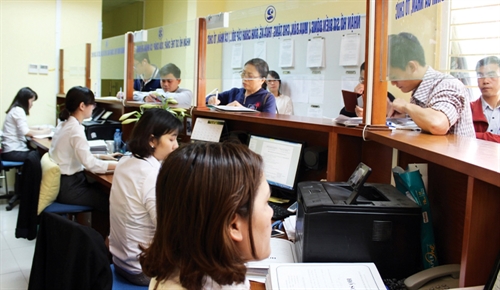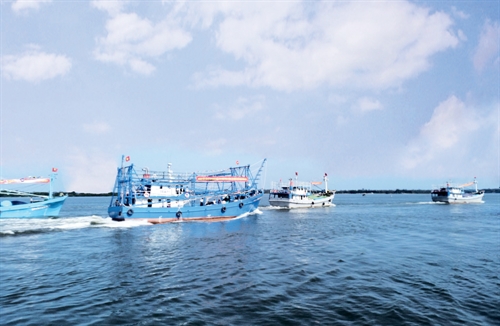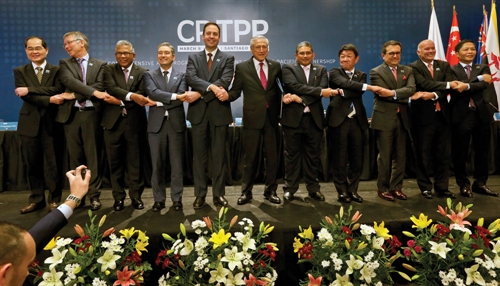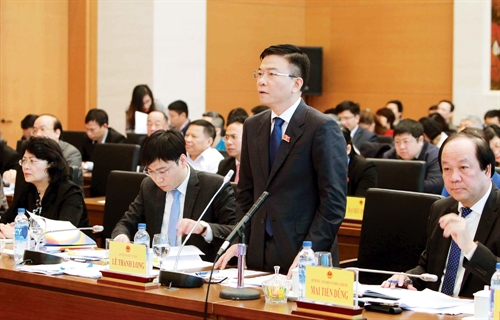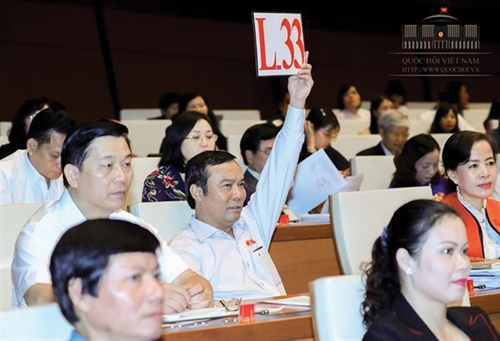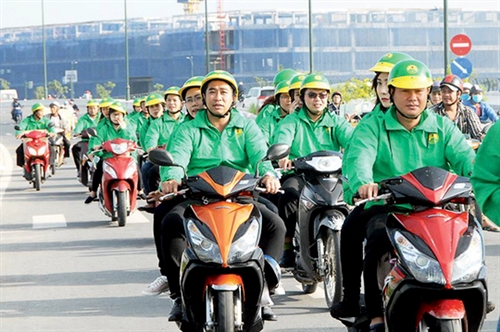Nguyen Van Thang and the Research Team[1]*
Vietnam’s impressive industrialization and associated reduction in poverty has come at a high cost to the natural environment. According to the Environmental Performance Index,[2] in 2016 Vietnam ranked in the top 10 countries with the worst air quality (Hsu A. et al., 2016). When asked about trade-offs between economic development and environmental protection, in 2016, 77 percent of respondents from nationwide surveys, the Vietnam Provincial Governance and Public Administration Performance Index (PAPI)[3], suggested the state should prioritize environmental protection even at the risk of economic growth. Currently there is limited research on how different perceptions about what constitutes an equitable balance between economic development and environmental protection influence environmental disputes in Vietnam. We consequently know very little about how different stakeholders conceptualize and respond to environmental disputes, how such disputes occur in practice, what drives them, how they affect citizens, and what constitutes appropriate public policy responses, and dispute resolution practices.
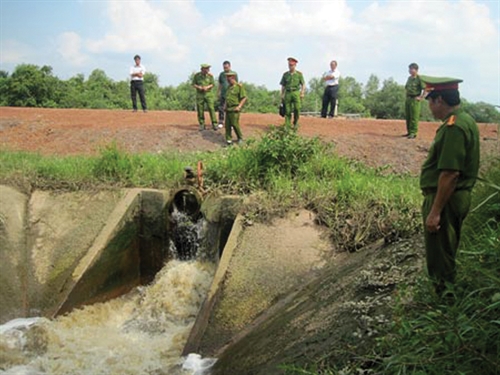 |
Wastewater discharged from Long Thanh Industrial Park, Dong Nai province__Photo: Internet |
In 2017, the National Economics University (NEU) and the United Nations Development Program (UNDP) in Vietnam conducted a study on environmental conflict, distributive justice, and social change in Vietnam. The research paper coming from the study was launched in January 2018. The study is based on distributive and procedural justice frameworks to analyze how different stakeholders conceptualize the conflicts, their causes and consequences. This study draws on 17 reported cases in the government database and five in-depth case studies about environmental disputes between businesses and citizens. Disputes were selected for both their relevance to business-citizen disputes, occurring within the last five years, and maturity, having proceeded through different stages of disputation including complaint, negotiation and resolution. Regional diversity and access to interlocutors, such as local officials, businesses, citizens, media and non-governmental organizations (NGOs), were additional selection criteria.
Findings
The Table summarizes key information and analysis from the cases.
Table: Summary of environmental disputes in five studied cases
| Tan Dong Hiep Quarrying Mine | Sonadezi Long Thanh | Song Lam Sugar Co. | Firms in Cau Luong River | Thuy Hai Food Processing Co. | |
| About the case | This dispute occurred near the Tan Dong Hiep quarrying mine, in Di An town, Binh Duong. The mine has operated since 1993. The dispute arose because the quarry is located close to residential areas. | This dispute occurred in Long Thanh Industrial Park, a joint stock company with 51 percent state ownership. The park has more than 100 firms. Citizens of Tam An commune have been conducting agriculture business in close proximity to the park and the Dong Nai River. | The Song Lam Sugar Co. moved to Anh Son district in 1998. It produces sugarcanes, fertilizer and alcohol. The increase in production during 2009 - 2010 gave rise to complaints about environmental pollution among local citizens. | Cau Luong River irrigates and drains nearly 2,000 ha of agricultural land in Van Lam and My Hao districts, Hung Yen. Sewage from firms is considered the most important cause of pollution in the river. Citizens protested against firms for years. | In 2003, Thuy Hai Food Processing Co. was established and located in Thuy Hai commune, Thai Binh. Citizens complained about smells from the firm since 2005, and the protests peaked during 2011 - 2012 with hundreds of people blocking the firm’s gate. |
| Result by December 2017 | Disputes on house cracking have not been resolved | Almost all impacted households received “financial support”, the dispute was resolved | Citizens accepted that the firm has upgraded technology - the dispute has been resolved | Five firms have been fined (2010 - 2016), but pollution persists. Citizens keep complaining. | The firm moved to new place (2013). The dispute has been resolved. |
| Distributive justice | Citizens complained the quarry operation pollutes the surrounding area with noise, vibration and dust, and cracks their houses. The firm and local government confirmed the firm followed regulations; and technology is used. |
Citizens believed the pollutions by the IP are harmful to their health and agricultural livelihood. The pollution is not one-off incident. The firm and local government confirmed that they followed regulations (only one-off incident), the firm contributed greatly to local development |
Citizens are divided where come groups benefits from the firm, while nearby communities suffer pollution. The firm and local government argued that the firm has upgraded its technology. The firm has a great contribution to local development. |
Citizens blamed the firms for damaging the natural environment. Their health and livelihood suffer. The firms argued that they followed regulations, and that it is not clear who are the causes of pollution. |
Citizens complained for the negative effects on their health and fishing livelihood. The firm believed this was unfair competition (rather than environmental issues). |
| Procedural justice | Citizens complained The firm and citizens negotiate on “support” amount and beneficiaries Complaints on house cracks have not been addressed |
Citizens complained since 2005 Local government acted in 2011 with evidence of IP violation. Research institute helped assess the impact area |
Citizens complained and hostilely protested against the firm Local government acted in 2012 with violation evidence. The firm updated technology. |
Citizens complained and hostilely protested Local government found evidences and fined five firms Pollution continues at high level |
Citizens complained since 2005, the firm and government believed the issue was not serious Citizens hostilely protested in 2011-2012, the firm had to move out |
Four key lessons emerge from the study.
Learning point 1: The state-based administrative management system, on its own, cannot control environmental pollution.
The government uses a combination of spatial planning and administrative licensing to manage the emission of pollution, (i.e., the government sets and monitors compliance with emission standards). This approach is only partially effective in controlling pollution for several reasons. Firstly, the government lacks sufficient resources, knowledge and skills required to effectively monitor and enforce standards. Most provinces have approximately 15 environmental police officers and about the same number of environmental inspectorate officials (Ortmann 2017). As provinces have about 20,000 to 30,000 firms, each environmental police officer is required to monitor 1,000 to 2,000 firms. Secondly, trust in local government varies greatly among localities. Citizens that were interviewed in the five case studies, for example, concluded that the governments did not always rigorously enforce environmental standards or act independently from polluting firms.
What is missing in Vietnam is citizen engagement in environmental management. Effective citizen participation requires organization and support from non-state and professional organizations. In the cases studied, citizens lacked access to independent and technically competent expertise. Media, social network, and business codes of conduct also played a peripheral role.
Learning point 2: Citizens conceptualize environmental harm as a violation of procedural and distributive justice
Citizens conceptualized environmental harm in terms of procedural and distributive justice more than infringements of personal/subsistent or property rights. They believed that polluters disproportionately benefited from natural resources, while citizens disproportionately endured the burden of environmental harm. Citizens rarely perceived the harm caused by environmental pollution as infringements upon legal rights to persons and property. Although the case studies considered damage to rural communities, it is possible that urban citizens, who were not considered in this study, might deploy rights-based understandings of environmental harm.
Learning point 3: Citizens take direct action when state-based dispute resolution fails
The case studies show that when state-based methods of dispute settlement fail, citizens turn to high-risk protesting tactics. For example, citizens use collective protests and direct action, such as blocking access to polluting industries as negotiating tactics. A key reason for direct action is that citizens lack the support services needed for deliberative approaches to dispute resolution, such as fair discussions with involved actors and access to legal and technical assistance. The other reason is that direct action is often more successful in attracting responses from local governments than the use of state-based institutions like the mainstream media or courts. Finally, based on the case studies, it is clear that citizens’ lack of trust in political authorities may obstruct even sincere attempts from local government and firms at resolving the disputes. This points to the need to involve non-governmental and/or quasi-governmental mediators, which might help generate trust.
Learning point 4: Lack of non-state and professional mediators
Although the 2014 Law on Environmental Protection (LEP) recognizes the Vietnam Fatherland Front (VFF) as a potential mediator for environmental disputes, in practice, VFF and its member organizations play a peripheral role. In the selected case studies, local government officials acted as mediators, but citizens lacked access to organizations (e.g., state-supported local lawyers’ associations and legal aid services) that were capable of providing legal and technical assistance, and acting as impartial mediators. The need for neutral actors, with experience in resolving environmental disputes, is especially pertinent where citizens do not trust local governments to act neutrally.
Before discussing policy implications and the way forward, we caution readers on the limitation of the study. The analysis and findings have been based on the Ministry of Natural Resources and Environment (MONRE)’s documents of 17 disputes and our five in-depth case studies. The information and analysis have not adequately addressed the roles of media and social network in the environmental movement. Future research should address this issue to shed light on relevant policy and legal reforms.
Policy implications and the way forward
As Leaning Point 1 shows, Vietnam relies primarily on top-down command and control regulation, and underutilizes the regulatory potential of public participation in environmental governance. This regulatory approach relies primarily on the state (especially local governments) to promote distributive justice and determine who should benefit most from the environment.
International experience suggests three ways to strengthen environmental regulation in Vietnam. Firstly, it is possible to rectify procedural problems with top-down regulation. Secondly, it is possible to minimize the risk of environmental disputes by encouraging bottom-up citizen regulation and increasing regulatory pluralism. Thirdly, neutral and impartial mediation has the potential to resolve many environmental disputes.
Rectifying problems with top-down regulation
Much of the regulatory burden for approving and monitoring environmental impacts in Vietnam falls on central bodies that lack sufficient resources to rigorously verify claims made in license applications (Article 23 of the 2014 LEP), and ensure that local authorities monitor and enforce environmental impact assessments (EIAs) and environmental impact statements (EISs) (Ortmann 2017, Chapter 3).
Problems with monitoring compliance
The 2014 LEP focuses on developing, rather than monitoring compliance with EIAs. Article 26 makes project owners responsible for compliance with EIAs, while Article 28 makes local authorities responsible for ensuring that pollution abatement has been completed. But surprisingly, there are no concrete provisions requiring monitoring after EIAs have been granted. Article 121 only requires on-going monitoring for firms designated at risk of harming the environment.
International experience shows strong monitoring and enforcement from both state and non-state actors are required to give the law authority. Low levels of compliance and weak enforcement are mutually reinforcing, creating a chain reaction with potential to undermine the 2014 LEP.
 |
Cau Luong river in Hung Yen province is seriously polluted__Photo: Internet |
It is recommended that the 2014 LEP be amended to stipulate continuous monitoring of EIAs and EISs by state and non-state actors. In addition, EIAs and EISs should be made publicly available to encourage monitoring by non-state actors. The Aarhus Convention on Access to Information, Public Participation in Decision Making and Access to Justice in Environmental Matters (2001)[4] provides the best practice model regarding public access to environmental information. The China Pollution Map project also provides a possible model of citizen monitoring.[5]
Problems with EIA and EIS processes
Once investment licenses are granted (Ortmann 2017, Chapter 3), an expectation arises that EIAs will also receive official approval (VIR 2016). The Indonesian Environmental Protection and Management Law (2009) avoids this problem by requiring the approval of EIAs before business licenses are issued.
It is recommended that the 2014 LEP be amended so that investment/business licenses can only be issued after EIAs have been approved. In addition, the 2014 LEP should be amended to provide a less technically complex processes governing the issue of EIAs for small and medium sized enterprises (Ortmann 2017).
Encouraging bottom-up citizen regulation
Learning Point 4 shows that citizens in Vietnam have few opportunities to participate in state-based environmental regulation. A key consideration in encouraging public participation in state environmental regulation is whether citizens can detect and respond to environmental harm. Citizens, for example, can play a vital role in identifying environmental harm because they often have daily information concerning on-the-ground pollution. However, mere access to information does not automatically result in effective control and prevention of environmental risks. International experience shows that citizens need the assistance of professionally capable social organizations to effectively monitor and pressure polluting industries.
Court actions
There is considerable scope for citizens to take direct action to curb environmental harm. Leaning point 2 shows that many citizens do not conceptualize environmental harm as infringements upon legal rights that protect personal health and property. As a result, they rarely consider litigation as a possible remedy. Negative perceptions about the competency and impartiality of courts also limit the scope for litigation (see UNDP 2016; Ortmann 2017). Despite these barriers, environmental litigation is recommended as a long-term measure for protecting people’s rights and ensuring environmental justice. Capacity building for the collection of environmental evidence for litigation is also recommended.
Under the existing LEP, citizens affected by pollution may sue polluters, and ask courts to determine whether and how such harm should be remedied. However, Vietnamese citizens rarely, if ever, consider court action as a viable cause of action in environmental disputes. In 17 environmental disputes reported in MONRE’s database, affected citizens filed a lawsuit against polluters in only one case. This concerned pollution in Cha Va River in Ba Ria-Vung Tau province. Another major constraint to environmental litigation is that environmental pollution usually affects many people and is technically complex, but affected citizens lack the knowledge and skills required to compile the evidence needed to support litigation. International experience shows that litigants need to mobilize resources for complex environmental litigation. For example, the 2009 Environmental Protection and Management Law of Indonesia gives citizens the right to take class actions, and the 2015 Environmental Protection Law in China allows NGOs to mount environmental litigation on behalf of communities.
The 2011 Law on Denunciations (Article 19) allows class actions. It is recommended the 2014 LEP and related legal documents be amended to allow class actions in environmental litigation, and allow NGOs and/or independent institutions to mount environmental litigation on behalf of affected communities. NGOs and independent institutions can support affected communities in compiling the evidence required for environmental litigation.
Public participation in environmental regulation
Studies show that the current regime in Vietnam does not facilitate meaningful citizen participation in environmental regulation (O’Rourke 2003; Thang and Ha 2014; Ortmann 2017). Citizens have few opportunities to influence the spatial planning that determines the location of polluting industries, or opportunities to influence the standards used in EIAs and EISs. For example, although Article 21 of the LEP 2014 requires project owners to consult “communities that are directly affected by the project”, it does not require public meetings that might allow transparent and meaningful deliberation that informs licensing decision-making. In many cases, concerned citizens are notified after licensing decisions have been made, reducing the possibly meaningful participation in decision-making.
International experience shows that public participation can expand the policymaking circle to include the interests of those most directly affected by developments (McCarty and Zen 2010). It can change how the environment is conceptualized and how businesses respond to public interest concerns. Participation shifts the role of citizens from end-users, who are consulted tokenistically, to active stakeholders and development partners. Recognizing the importance of public participation, the 2009 Environmental Protection and Management Law of Indonesia requires public hearings during the preparation of EIAs, and before environmental licenses are granted. The 2001 Aarhus Convention on Access to Information, Public Participation in Decision Making and Access to Justice in Environmental Matters provides the “best practice” model for public participation in environmental decision-making.
It is recommended that the LEP 2014 and related laws be amended to give concerned citizens the right to participate in public hearings and influence the spatial planning of polluting industries and the preparation of EIAs and EISs. Government authorities should not only have a duty to record and publicly disseminate transcripts of public hearings and the recommendations made by citizens, but also to base environmental planning and licensing decisions on recommendations made at public hearings.
Promoting citizen participation in environmental decision-making
Studies further show that even if citizens are given access to public meetings, they often lack the knowledge and skills required to evaluate project proposals, and assess how projects might harm the environment and their interests (see Learning Point 1). International experience (discussed in Appendix 2) suggests that citizens need institutional support to mobilize resources, and draw on accumulated organizational skills and knowledge. In China, the state has created “deliberative design” institutions that give citizens the resources to make evidence-based recommendations regarding the location of polluting industries. The Indonesian government has liberalized the establishment of community-based and national environmental NGOs, and it is these organizations that have promoted citizen participation in environmental decision-making.
It is recommended that Chapter 15 of the 2014 LEP (and associated legislation) be amended to allow the formation of community-based and national environmental NGOs with the right to mobilize resources to monitor and enforce compliance with the law and represent the public in protecting the environment.
Deliberative designs
The Chinese experiment with deliberative designs offers a promising way to increase public participation in environmental decision-making. Policymakers who want to consult the public directly face a dilemma. If they consult the public, the opinions they receive are largely uninformed (He 2011). Most citizens lack knowledge and skills to analyze complex environmental issues. But if policymakers do not directly consult the public, and allow organized interests to speak for the people, then environmental planning becomes unrepresentative.
Deliberative designs have been developed to enable policymakers to conduct public consultation directly and bring a wide range of well-informed voices into the policymaking loop. Deliberative designs aim to:
• mobilize citizens by providing the resources and expertise required to analyze environmental projects;
• provide opportunities to question stakeholders and experts (such as fiscal experts, environmental scientists, planners and academics);
• encourage reasoned communication between policymakers and citizens that conveys new and possibly controversial views; and,
• develop a set of written recommendations that inform the policymaking process.
The assumption underlying deliberative designs is that in a cooperative and well-informed environment, individuals are less adversarial and self-interested, and more prepared to reflect upon different views and reach negotiated compromises.
It is recommended that a pilot deliberative design be trailed to guide the planning and development of a large-scale industrial project with the potential to harm the environment.
Enhancing responsible business sector
This recommendation relates to building an innovative, responsible, and integrated business sector. Environmental disputes will only be sustainably prevented and/or resolved when businesses voluntarily and responsibly engage in environmental protection and attend to environmental justice. To foster this sense of social responsibility, we offer three recommendations. Firstly, social responsibility in general, and environmental responsibility, should be included as a key content in university business studies curricula. In addition there should also be integrated short-course training in this area for businesses. Secondly, financial institutions should consider using environmental performance as a condition for granting funding. Thirdly, firms with better environmental performance (based on historical records and environmental management certificates such as ISO14000) should be put in fast-track for administrative issues so that firms would be able to save time and improve their productivity.
Meditating environmental disputes
Learning point 2 shows that Vietnamese citizens conceptualize environmental conflicts in terms of procedural and distributive justice, rather than legal rights. International experience shows that mediation is the most appropriate means of resolving this type of conflict. Indonesia’s experience demonstrates the usefulness of narrative mediation in resolving environmental disputes. Mediators use narrative mediation to encourage disputants to share stories about the conflict, and find points of agreement that can bridge conceptual differences. They do not attempt to assess the truth behind stories, rather they focus on understanding how different parties conceptualized the dispute. They aim for a solution based on the narratives the disputants tell, rather than upon some external framework, such as laws and state policies.
This approach is well suited to environmental disputes because it provides a non-blaming approach that reduces the emotional temperature of disputes, and increases trust. It also generates a joint understanding about how past events have generated disputes and the solutions required to move forward. This approach helps overcome the power asymmetries between businesses and citizens.
As the five case studies reveal, there are many different, often contradictory, perspectives about the problems underlying environmental disputes. Mediators can reconcile differences and then shift the discussions about how disputes harm personal interests to consider what can be done to resolve the situation.
International experience shows that the selection of well-trained and neutral mediators is vital for successful environmental mediation. Mediators need to attract the respect of the disputants. Also, they must be energetic and enthusiastic, knowledgeable about local customs and the environmental issues, and, most importantly, unbiased and impartial about the community’s interests. Well-resourced environmental NGOs have played an active role in mediating environmental disputes in Indonesia, as have specialized university environmental institutes.
It is recommended that the 2014 LEP and related legislation (such as the 2012 Law on Water Resources) be amended to establish a clear framework for non-state mediation of environmental disputes. Indonesia’s 2009 Environmental Protection and Management Law provides a useful model (see also ISPONRE 2013).
In addition, consideration should be given to funding and trailing environmental mediation. With appropriate training, university-based environmental institutes could act as centers for environmental mediation in Vietnam. Alternatively, retired state officials, such as environmental police officers or members of the Vietnam Lawyers Association, might be suitable environmental mediators.-
